Statistical Data Processing Results of the “Overcoming Shock Trauma and PTSD” Bodynamic Trainings for the Ukrainian Veterans. Group 1.0 and 2.0
Preliminary Research Report
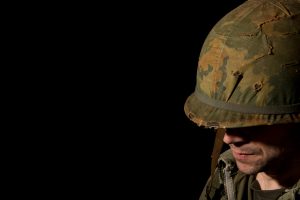
Introduction.
Overcoming Shock Trauma and PTSD Bodynamics Training for the Ukrainian veterans is aimed at the post traumatic growth of the combat operations participants and is based on the “equal to equal” principle. The training is created by Ditte Marcher, Director of Bodynamics International, and is based on the 30 years of experience working in the war zones. The training was first carried out in Denmark for the Danish veterans in 2013-2014, and the veteran organization VaKa was established as the result. The first training in Ukraine was taught by Ditte Marcher and the Ukrainian assistants in 2015 based on the contract and the request of the Healing War Scars organization. Four groups of veterans graduated the training based on this methodology in 2016, two of these by “Pobratymy” organization and two groups (1.0 and 2.0) by Healing War Scars. The training consists of the 4 levels. The following tasks are accomplished at each level:
- To increase the awareness of the veterans’ own psychological states, start to create the safe places and find safe people.
- To provide the opportunity to find and realize resources for rehabilitation in one’s own body.
- To assist the participants in the investigation of their own shock history and in assimilation of the peak experience.
- To create the opportunity for reorientation and post traumatic growth.
Methodology.
The following physiological evaluation methods were used in order to estimate effectiveness at the different training stages:
- PTSD probability evaluation, PTSD symptoms manifestation: PCL-5, PTSS-10, PTSD screening.
- Mississippi scale for traumatic reactions evaluations: MS.
- Dissociation disorder: DES.
- Depression disorders: BDI, PHQ-9.
- Post traumatic growth evaluation PTGI.
- DRRI-2.
Psychological status of the participants was studied taking into account the changes in the symptoms level criteria distribution, for example “absent, low, medium, high” and not the group average; since the number of participants changed we used the percentage of the participants; statistical methods such as Student’s t-test, Mann-Whitney U-test, Pearson correlation coefficient of the statistical significance SPSS 17.0.
Clinical Study Authors
Oleh Novak, Ukraine – clinical psychologist in NGO “Ukrainian association on recovery after psychotraumatic events”, psychotherapist, EMDR-therapist, member of Ukrainian Psychological Crisis Service.
Did evaluation and statistics in the report.
Oleh Hukovskyy – Psychiatrist from Ternopil State Medical University, Head of Day Care unit at Ternopil Regional Psychoneurological Hospital (2013-15), Psychotherapist, Lead Trainer at Healing War Scars and international teacher/ trainer in Bodynamic International.
Has created set of diagnostics, collecting data, and keeping connection with veterans during the whole period of observation.
Group 1.0
Data Processing IES
IES methodology is used to study and evaluate the symptoms that could occur after the traumatic event. In the context of our study the IES scale was used to test the therapeutic success of the training.
The change of the criteria level is shown in the diagrams 1-3. The levels of the symptoms decrease, i.e. from 0% of “clinically absent” status at the beginning to 15% at the end of the 4th training module. There was a decrease in the number of persons with severe manifestation of the symptoms from 40% at the 2nd training module to 8% by the 4th module.

Diagram 1. Symptoms manifestation (total) using IES scale during Group 1.0 2nd training module

Diagram 2. Symptoms manifestation (total) using IES scale during Group 1.0 3rd training module

Diagram 1. Symptoms manifestation (total) using IES scale during Group 1.0 4th training module
Changes in symptoms severity dynamics using IES scale are also presented in Diagram 4:
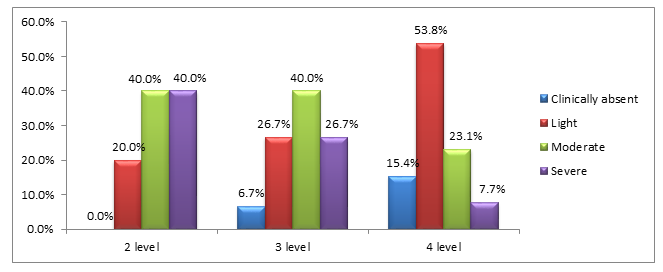
Diagram 4. Changes in PTSD symptoms severity dynamics using IES scale in the Group 1.0 during the 2-4 training modules
Student’s t-test analysis of the changes in PTSD symptoms severity by IES scale (total score) in the group during the 2-4 training modules revealed statistically significant decrease between the second and the fourth levels: t=2,42 > tкр (tкр=2,056 with p<0.05). The greatest positive dynamic (even though statistically insignificant) is seen between the third and the fourth levels (t=1,79) in comparison to the period between the second the third levels (t=0,68). The occurred changes most likely due to the processing of the experiences that happens during the third level.
Individual symptoms criteria dynamic for the Group 1.0 participants for the duration of the training is represented in Diagram 5, where 1-15 is the number of each group participant.
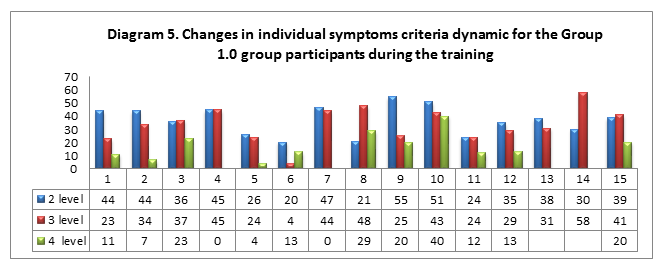
Data Processing PCL-5
The increase in the PTSD symptoms criteria average by 4,4 points according to the PCL-5 test was observed for the group during the period between the 4th level and 4 month after the end of the course. This was due to the increase of the symptoms manifestation for the 53% of the participants (7 people). At the same time 41% (6 people) demonstrated the decreased of the symptoms. The limit of 38 points (diagnostically significant number) was exceeded by 2 people during the 4th levels, and by 3 people after 4 month. At the same time we observed decreased in symptoms by 9 points for one of the participants and for two participants there was an increase by 27 and 9 points respectively. Diagram 6 represents PTSD symptoms manifestation during the 4th level and in 4 month after the course.
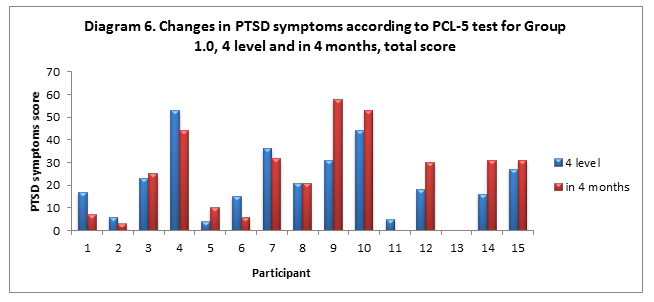
Statistical analysis of the PTSD symptoms change significance by the PCL-5 scale (total points) between the period of the 4th level and 4 month after the training did not reveal any significant changes: t=0,71 < tкр (tкр=2,06 with p<0.05).
As can be seen from Diagram 7, 23.1% of the participants do not estimate their symptoms as clinically significant (PCL-5 test accepts the estimate 2 (“Moderate”) or higher as the symptom confirmation). 76.9% demonstrated at least one (or more) groups of symptoms, 38.5% – four groups of symptoms. Based on these preliminary results further psychometric measurements could be suggested in order to further clarify PTSD diagnosis.
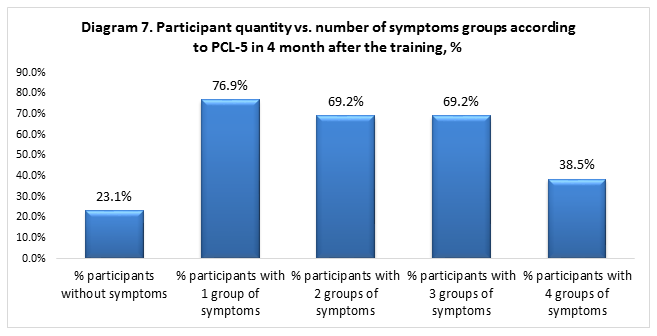
Diagram 8 presents the most and the least experienced symptoms in 4 months after the end of the training course. The most common symptom among the respondents is “Are you very upset when something reminds you of the stressful event?” – 69.2% of participants, “Memories of the stressful event that are reoccurring and disturbing are undesirable?” – 61.5%, “Were you in the state of “excessive alertness”, vigilance, caution?” – 46.2% participant. Consequently the symptoms that are revealed by the questions ## 2, 8, 14, 15 by the PCL-5 scale are the least prominent.
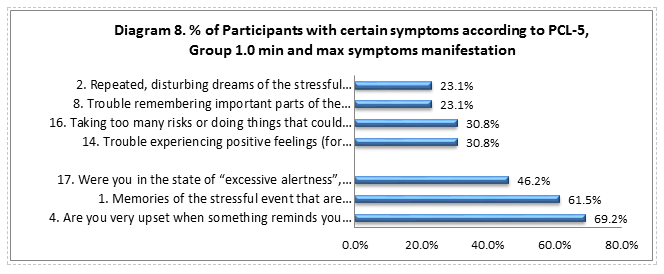
As seen from the Diagram 9, the most prominent group of symptoms (according to PCL-5 test) is “Memory Intrusion” (B), the least prominent is “Avoidance” (C). “Alienation, inability to experience positive emotions” (D) and “Overexcitement” (E) occupy an intermediate position.
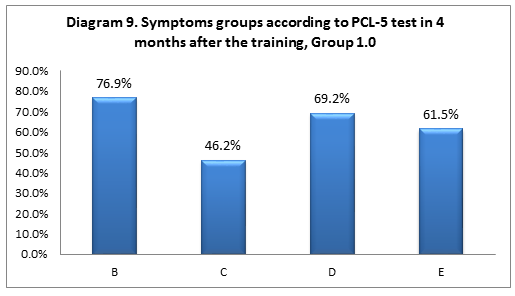
Data processing DES
70% (9 people) demonstrated decrease in the individual DES criteria. The number of participants with clinically diagnosed dissociation symptom criteria decreased by 7% (1 person).
DES criteria average did not change significantly between the second module and after 4 month of the training.
Statistical analysis of the changes in dissociation disorder symptoms significance by DES scale did not reveal verifiable changes between the second module and after 4 month of the training: t=0,13 < tкр (tкр=2,06 with p<0.05).
Data processing MS
Data comparison by the MS methodology revealed a decrease in the level of the symptoms manifestation: 15% of the participants demonstrated his level of the dysfunctions at the 2nd level while by the end of the 4th level there were 7% such participants. Symptoms increase during the 3rd level up to 23% could be related to activation of the defense mechanisms at the stage of the traumatic experiences processing.
Statistical analysis of the changes in dissociation disorder symptoms significance by MS scale did not reveal verifiable changes between the second module and after 4 month of the training: t=1,19 < tкр (tкр=2,06 with p<0.05). Statistically significant changes are also absent between the 2nd and the 3rd modules (t=0,29) and between the 3rd and 4th levels (t=1,57 < tкр, при tкр=2,06, p<0.05).
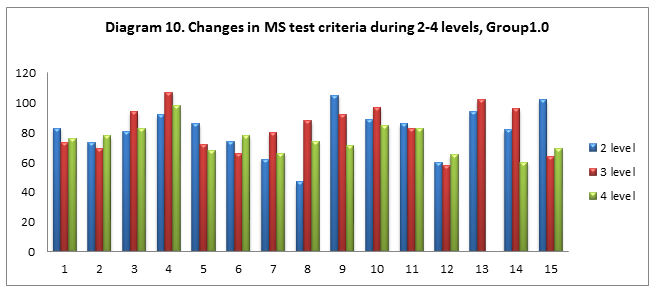
Data Processing PTSS-10
Estimation of the post traumatic condition probability criteria changes according to PTSS-10 demonstrated its decrease from 2nd to 4th training level while maintaining the effect in 4 month (see Diagram 11).
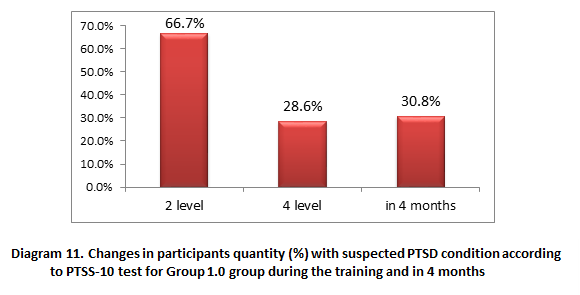
Data Processing BDI
Decrease in depression symptoms level is observed during the course of 2-3 modules (according to BDI scale) and also after 4 months (according to PHG-9 scale). Diagram 12 demonstrates the symptoms levels for the training levels and in 4 month (in percentages). 85% of the participants demonstrated decrease in depression criteria, 15% – demonstrate insignificant increase.
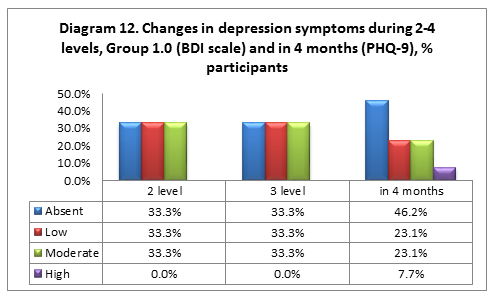
It should be noted that increase in symptoms according to several tests observed for participant #14 during the 3rd training module could be related to coping with a sudden death of his son.
Data Processing PTGI
Post Traumatic Growth Inventory (PTGI) (Tedeschi & Calhoun, 1996)) during the period “level 4 – in 4 month after the end of the training” revealed that 33% of the participants demonstrate increase in criteria, which attests to delayed positive dynamic. 58% demonstrate decrease in the post traumatic growth level, 1 participant (8%) did not show any changes. This may indicate the need for additional support during the first period after the end of the training. Diagram 13 shows the distribution of the individual post traumatic growth criteria.
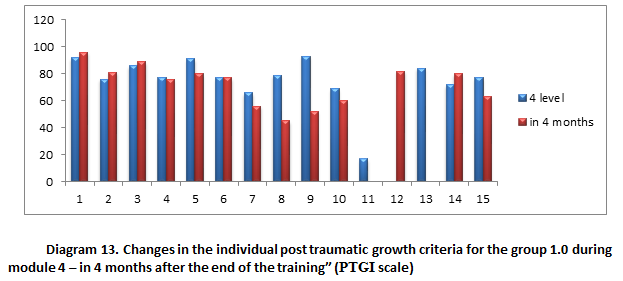
Statistical analysis results of the criteria changes reliability for several tests during training and in 4 months after the training is shown in Table 1. (for comparison).
Table 1.
Correlation analysis of the significance in the test criteria changes for the group 1.0 during the training stages (according to the Student coefficient).
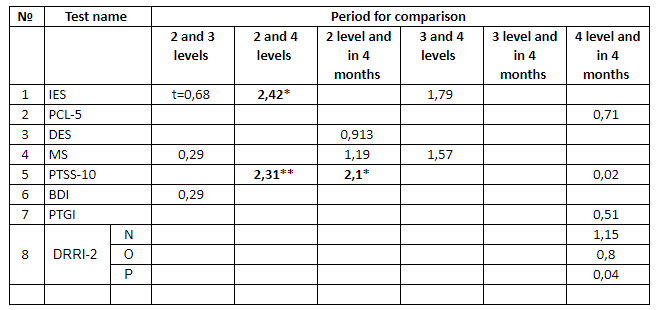
Statistically significant changes:
* – p<0.05
** – p<0.01
As seen from Table 1, significantly reliable changes for Group 1.0 occurred in the decrease of PTSD symptoms during the period of 2-4 levels (according to IES, t=2,42, p<0.05; PTSS-10 t=2,31, p<0.01), maintaining therapeutic effect in 4 months after the end of the training (PTSS-10, t=2,1, p<0.05). The absence of data is not always due to the absence of change in the symptoms but is rather due to the fact that comparison was carried out only for the tests technically administered at the certain training levels.
Participant #9 stands out among the others due to high dysfunctional criteria for different symptoms at the beginning and positive dynamics demonstrations during the training.
Correlation analysis of the test criteria relationship for Group 1.0 was carried out using SPSS 17.0 statistical package. The results are shown in Table 2.
Table 2.
Correlation analysis of the test criteria relationship for Group 1.0 (according to Pearson coefficient)

As seen from Table 2, PCL-5, PTSD screening and PTSS-10 tests correlate with each other, which could be an evidence of their mutual compatibility.
PTSS-10 was the most sensitive to post traumatic growth dynamic – increase in PTGI criteria is related to decrease in PTSS-10 (-0,558*, p<0.05).
PCL-5, PTSS-10 and PHQ-9 were sensitive to the changes in dissociation disorders. Depression is related to the PTSD symptoms and dissociation disorders (0,825**, p<0.01).
Bodynamic training is aimed to direct the participant to overcome their traumatic feelings and to promote post traumatic growth. Therefore we estimated possible connection between the components of the post traumatic growth (according to PTGI test) and other methods. Correlation analysis demonstrated that strengthening of faith and awareness of the fact that the participant is able to overcome present difficulties is the most important factor in PTSD symptoms decrease (-0,766, p<0.01 according to PCL-5; -0,8, p<0.01 according to PTSD screening; -0,671, p<0.05 according to PTSS-10), depression (-0,579, p<0.05) and dissociation disorders (-0,603, p<0.05) (see Table 3). An effective factor in reducing the symptoms of PTSD is the ability to turn to others for help and support (this is one of the structural and organizational conditions of the training among the anti-terrorist operation participants), the ability to see their strength, to believe in themselves and their abilities. This is also achieved due to the content of the training aimed at development of reflective thinking, a better self-understanding, restoring a sense of control over their conditions, skills training, mutual support.
Additionally it can be concluded that PTGI survey is in good correlation with the PTSD symptoms test and to the lesser extent with comorbid disorder tests.
Table 3.
Correlation criteria between PTIG survey scale and other tests (according to Pearson coefficient)
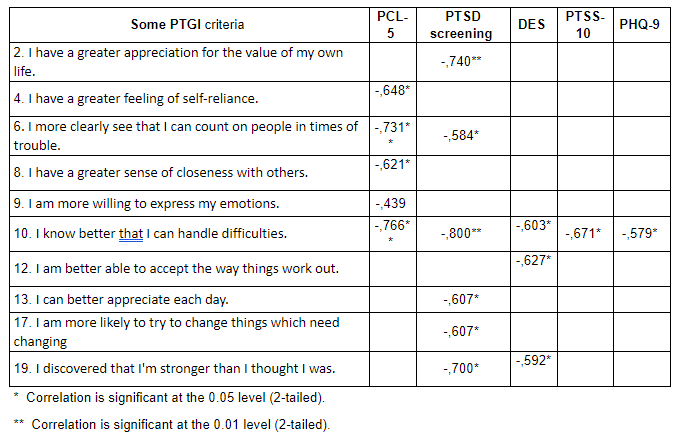
The hypothesis that the group participants involved in teaching the groups based on the equal to equal principle would demonstrate higher post traumatic growth criteria in 4 month after the end of their own training (level 4) was not confirmed. PCL-5, PTSS-10 and PHQ-9 tests showed that these trainers do not significantly differ from those not involved in such teaching (Table 6).
Table 6.
Comparison of PCL-5, PTSS-10, PHQ-9 tests for the trainers, who were teaching based on the equal to equal principle and those who were not involved in teaching (after level 4)

Group 2.0
The results of the statistical analysis of the reliability of changes in test criteria Group 2.0 during the period of levels 3 and 4 are shown in Table 1.
Table 1.
Correlation analysis of the significance in the test criteria changes for the Group 2.0 during the training stages (according to the Student coefficient).
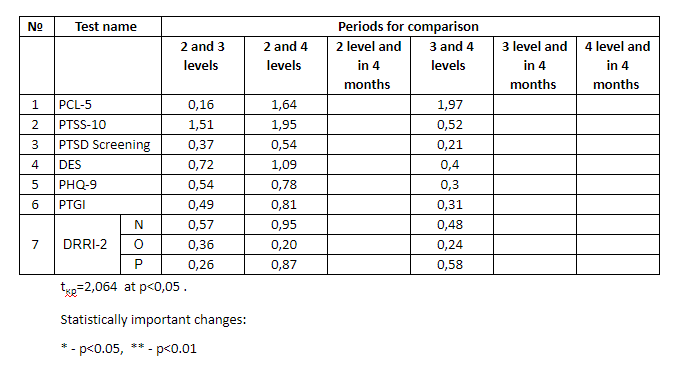
As can be seen from Table 1 there were no statistically significant changes between 2, 3, and 4 levels of the Bodynamic training (t < tкр=2,064 at p<0,05).
Statistical analysis of the PTSS-10 tests using Mann-Whitney correlation coefficient (SPSS statistical package) between the 2nd and the 4th training levels also did not reveal changes at the statistically significant level: 0,072>0,05 (see Table 2).
Table 2
U Mann– Whitney correlation coefficient values for PTSS-1 criteria between 2 and 4 training levels of Group 2.0
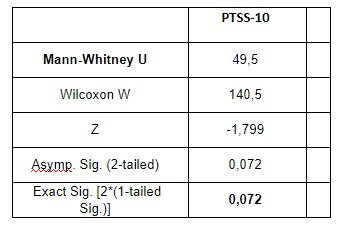
PCL-5 criteria manifestation and changes. PCL-5 test results processing revealed a decrease in PTSD symptoms criteria during 2-4 training levels. Diagram 1 presents the changes in symptoms manifestation.
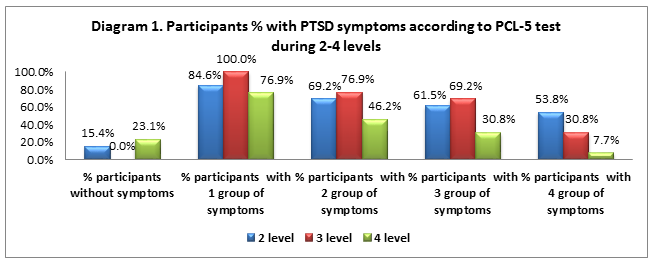
As can be seen, percentage of participants that did not show any PTSD symptom groups by 7.7% between the 2nd and the 4th levels (from 15.4% to 23.1%). Steady decrease of participant number that show all 4 symptom groups that could serve as a basis for PTSD diagnosis from 53.3% at the end of level 2 to 7.7% by level 4 (1 person) is observed. There was an increase in participants number with one, two or three symptoms between the levels 2 and 3. This might be related to the activation of experiences during the phase of traumatic experience processing. Respective decrease is observed during the 4th level – the phase of integration and reorientation of experience, direction to post traumatic growth.
Diagrams 2-4 present PTSD symptoms groups distribution according to PCL-5 tests for 2-4 training levels, where group B – memory intrusion symptoms, intrusions; group C – avoidance symptoms; group D – change in attitude towards oneself and the world symptoms: alienation, inability to experience positive emotions; group E – over-excitement symptoms.
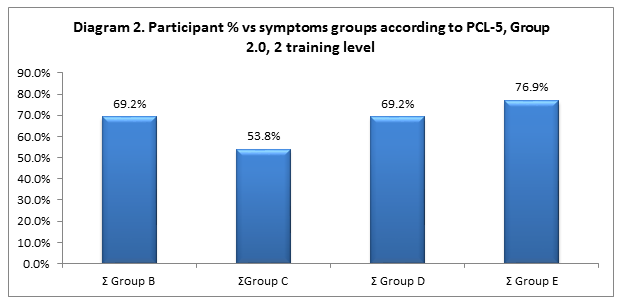
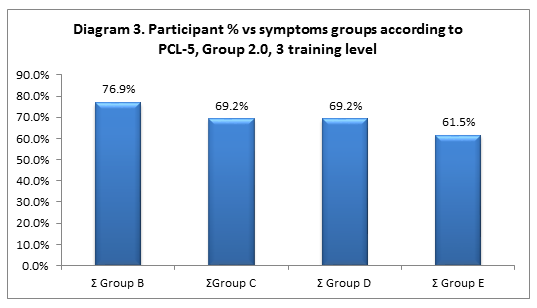
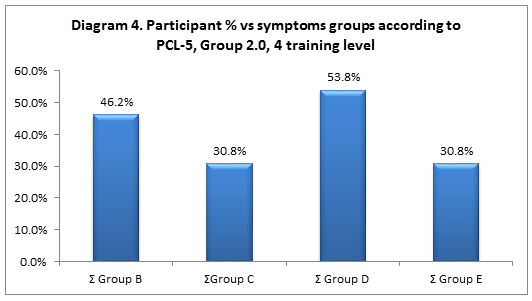
Changes in PTSD symptoms level is presented in Diagram 5 for demonstration purposes. There is a decrease in the participants quantity with all symptoms groups during the 4th level.
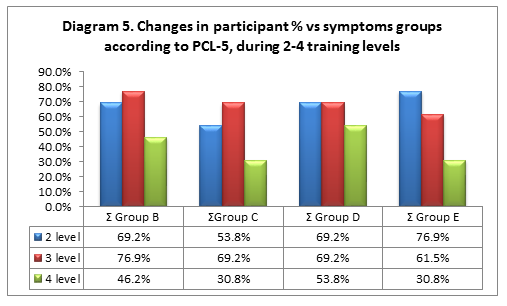
During the 3rd level (processing stage) an increase of memory intrusion and avoidance symptoms is observed, symptoms of over-excitement are decreased during the whole course of the training.
Diagram 6 presents the changes in PTSD symptoms manifestation level from level 2 to level 4. It can be seen that symptoms of group D are experience the most (by absolute value) – changes in attitude towards themselves and the world: alienation, inability to experience positive emotions.
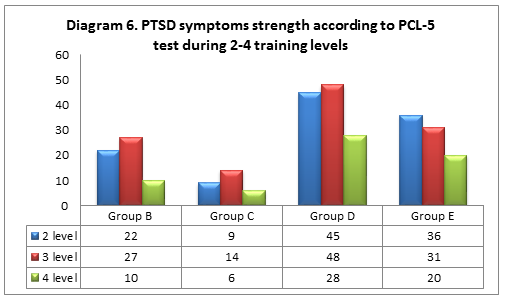
Correlation analysis of the relationship between the test criteria for Group 2.0 was carried out using SPSS 17.0 statistical package. Since the 4th level of the training demonstrated the most significant changes, we used the 4th level tests for the analysis. The results are presented in Table 3.
Table 3.
Results of the correlation analysis between the test criteria for Group 2.0 (according to Pearson coefficient)
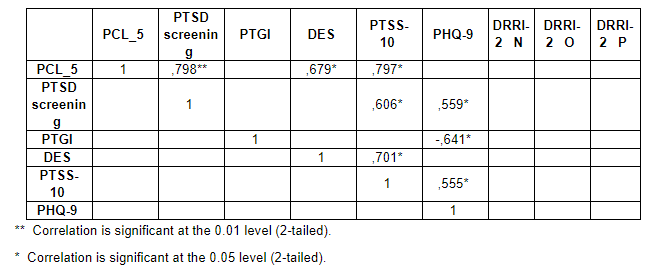
As seen from Table 1, PTSS-10 test is quite sensitive to the changes in depression criteria (0,555, p<0.05) and to dissociation disorders (0,701, p<0.05). Increase in post-traumatic growth criteria is related to the decrease in depression symptoms (-0,641, p<0.05). DRRI-2 test criteria did not reveal any significant correlation relationship with other tests.
Absolute changes in criteria
If the level of criteria manifestation during the 2nd training level is assumed to be 100%, it is established that:
- PTSD symptoms manifestation according to “PTSD Screening” method decreased by 6.6% during the 3rd level and by 10.8% during the 4th level;
- Post-traumatic growth criteria increased by 7.1% during the 3rd level and by 10.7% during the 4th;
- Dissociation disorders criteria decreased by 22.6% during the 3rd level and by 32.8% during the 4th;
- PTSD symptoms criteria according to PTSS-10 test decreased by 22.9% during the 3rd level and by 30.8% during the 4th;
- Depression disorders criteria according to PHQ-9 test decreased by 9.4% during the 3rd level and by 14.2% during the 4th;
- DRRI-2(N) test showed decrease by 15.7% during the 3rd level and by 27.2% during the 4th;
- DRRI-2(O) test showed decrease by 2.6% during the 3rd level and by 1.2% during the 4th;
- DRRI-2(P) test showed decrease by 3.2% during the 3rd level and by 9.4% during the 4th.
Data Processing PHQ-9
Diagram 6 demonstrates that during the course of the training the number of participants without the symptoms of with moderate depression disorders symptoms increase from 20% to 23.1% and from 46.7% to 61.5% respectively. Number of participants with pronounced level of depression disorders decreased from 6.7% to 0%.

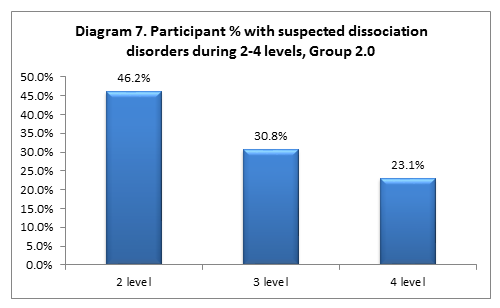
Data Processing PTSS-10
PTSD symptoms criteria analysis using the PTSS-10 method revealed a decrease in number of participants with suspected PTSD severe condition (diagnostic score – 12). Results are presented in Diagram 8.
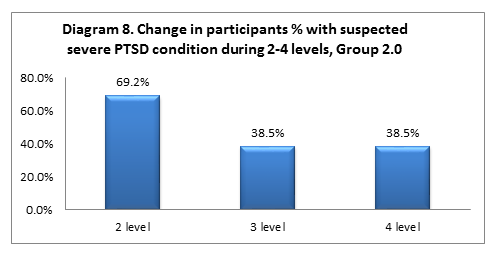
Data Processing DRRI-2
Change in DRRI-2 test criteria by N, O and P scales is represented in Diagrams 9-11.
Diagram 9. Change in DRRI-2 test criteria by N scale during 2-4 levels of Group 2.0, score
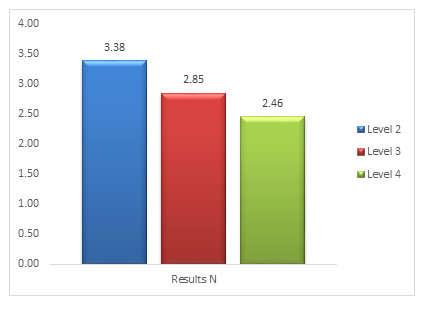
Diagram 10. Change in DRRI-2 test criteria by O scale during 2-4 levels of Group 2.0, score
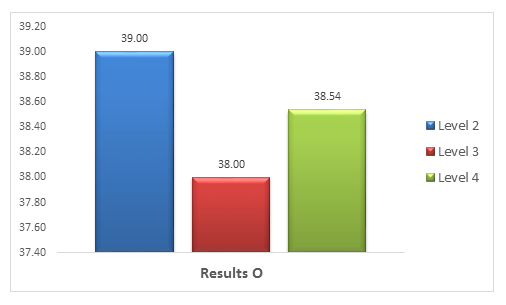
Diagram 11. Change in DRRI-2 test criteria by P scale during 2-4 levels of Group 2.0, score
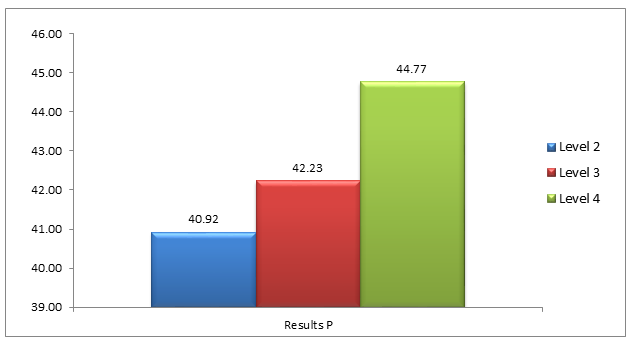
Table 4.
Comparison of the PTSD symptom criteria according to PTSS-10 tests for groups 1.0 and 2.0(Mann-Whitney U criterion)
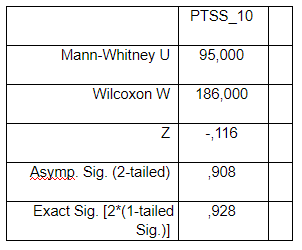
a Not corrected for ties.
b Grouping Variable: Warrior’s Heart
In the absence data that would allow to make comparison with other methods, we can assume that similar to the PTSD symptoms criteria probability and to dissociation disorders, other criteria also do not differ significantly between the groups. This means that changes in participants’ psychological status occur due to the therapeutically factor of the Bodynamic training course.
Table 5.
Correlation criteria between the scales of PTGI survey and some other tests (according to the Pearson coefficient)
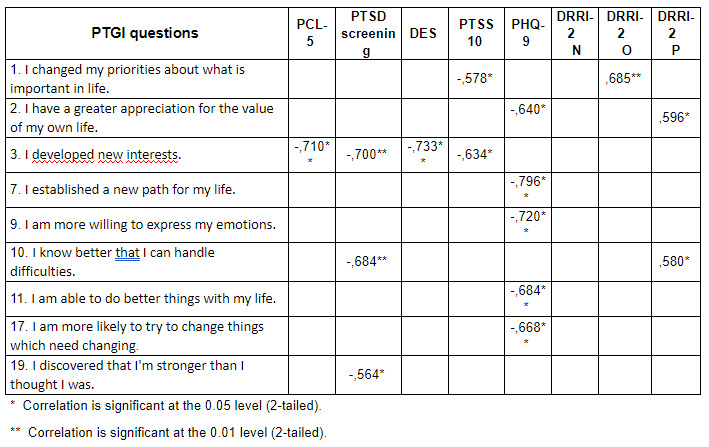
As seen from Table 5, the largest therapeutical effect in Group 2.0 has the appearance of the new interests for the participants: decrease in PTSD symptoms according to all three tests (PCL-5, PTSD screening, PTSS-10) and decrease in dissociation disorder symptoms (rxy=-0,733, p<0.01) is observed.
A decrease in depression symptoms is related to the increased awareness of the value of one’s life (rxy=-0,64, p<0.05), ability to direct one’s life into a new direction (rxy=-0,796, p<0.01), ability to expres emotions and feelings (rxy=-0,684, p<0.05), feeling of readiness and ability to change one’s life (rxy=-0,668, p<0.01).
Table 6 presents significant correlation relationship between scale “O” of the DRRI-2 survey and other test criteria used in our study. As can be seen, the strength of the post traumatic growth depends on how much the participant is able to feel the support of their environment and the recognition of their service in the Armed Forces (rxy=0,558, p<0.05). Ability to count on the family members or friends support affects the decrease in dissociation symptoms (rxy=-0,586, p<0.05) as well as PTSD symptoms (rxy=-0,558, p<0.05).
Table 6.
Correlation criteria between scale “O” of the DRRI-2 survey and some other tests (according to the Pearson coefficient)
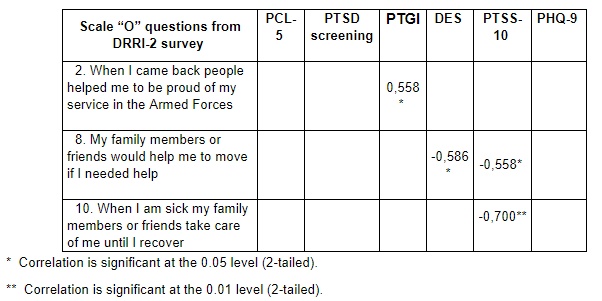
CONCLUSIONS
- The following methods are recommended for the evaluation of the psychological status and changes that happen to the Bodynamic training participants:
- PCL-5, PTSS-10 (PTSD signs);
- DES (dissociation disorders);
- PHQ-9 (depression disorders);
- PTGI, DRRI-2 (post traumatic growth).
- It was demonstrated that the PTSD symptoms decreased at the reliable level during the 2nd and the 4th modules of the Group 1.0 (IES, t=2,42, p<0.05; PTSS-10 t=2,31, p<0.01). The therapeutic effect was maintained after four month on training completion (PTSS-10, t=2,1, p<0.05).
- PTSS-10 test is the most sensitive method in regard to the other tests criteria. Increase in PTGI test criteria is related to the decrease in PTSS-10 criteria (for Group 1.0: -0,558, p<0.05). We have also observed connection between PTSS-10 test criteria and depression and dissociation disorders (0,555, p<0.05 and 0,701, p<0.05, respectively).
- The most important factor in PTSD symptoms decrease for Group 1.0 is a factor of strengthening faith and understanding that the participant is able to overcome current difficulties (rxy=-0,766, p<0.01 according to PCL-5; rxy=-0,8, p<0.01 according to PTSD screening test; rxy=-0,671, p<0.05 according to PTSS-10). It is also related to decrease in depression (rxy=-0,579, p<0.05) and dissociation disorders (rxy=-0,603, p<0.05).
- The most prominent therapeutic effect of the Group 2.0 training is related to the appearance of the new interests for the participants: we have observed a decrease in PTSD symptoms according to all three tests (PCL-5, PTSD screening, PTSS 10), and decrease in dissociation disorders symptoms (rxy=-0,733, p<0.01).
- It is established that post traumatic growth is related to the decrease in depression symptoms (Group 1.0,rxy -0,641, p<0.05). The extent of the post traumatic growth depends on how much support the veterans feel from their environment and recognition of their services by the Ukrainian Armed Forces (Group 2.0, rxy=0,558, p<0.05).
- Ability to count on support by their family and friends affects the decrease in dissociation symptoms (Group2.0, rxy=-0,586, p<0.05) as well as in PTSD symptoms (rxy=-0,558, p<0.05).
- Decrease in depression symptoms is related to increased awareness of the value of one’s own life (rxy=-0,64, p<0.05), opportunity to change one’s life direction (rxy=-0,796, p<0.01), ability to express emotions and feelings (rxy=-0,72, p<0.01), sense of ability of ability to improve one’s life (rxy=-0,684, p<0.05), sense of willingness and ability to change life for the better (rxy=-0,668, p<0.01).
- At the end of the training the most prominent group of symptoms (according to PCL-5 test) is “Memory Intrusion” (B), the least prominent is “Avoidance” (C). “Alienation, inability to experience positive emotions” (D) and “Overexcitement” (E) occupy an intermediate position.
- In general, the analysis suggests that attending the Bodynamic training contributes to decrease in PTSD symptoms (at the statistically significant level), depressive and dissociative disorders. Moreover, the training promotes post traumatic growth.
